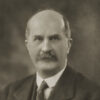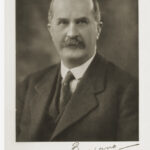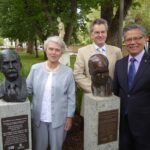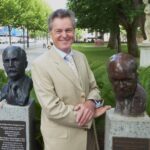This bust, sculpted in 2015 by SA artist Robert Hannaford, commemorates Professor William Bragg (1862-1942). Born in Cumbria, England, he came to Adelaide in 1886 as a young man of 23, having recently graduated in mathematics from the University of Cambridge and been appointed the first Elder Professor of Mathematics and Physics at the University of Adelaide.
The Scientist
William Bragg remains one of the University’s most distinguished professors, having been granted a Fellowship of the Royal Society of London whilst here and, on his return to England, the 1915 Nobel Prize in Physics for joint research with his elder son, Lawrence, on X-Ray Crystallography. Later William was knighted and became Director of the Royal Institution of Great Britain, a member of the Order of Merit, and President of the Royal Society of London.
In 1904 while at Adelaide, William discovered the “Bragg ionisation peak”, a sharp maximum of energy deposition when charged particles are stopped in matter. In 1946 Prof Robert Wilson of Harvard suggested the peak could be used to treat difficult – to -reach cancers in radiotherapy. After much lobbying by the Royal Adelaide Hospital, a Proton Therapy Centre is to be established on North Terrace at SAHMRI, the first in Australia.
Professor Bragg had an extraordinarily active university career in Adelaide, being involved in teaching, research, school education, and public service and lectures, notably a public demonstration of X-rays shortly after their discovery in 1895. He was a member of the University’s governing Council and initiated world-class research into the alpha particles from radioactive decay. In his 1912 book, Studies in Radioactivity, reporting work done in Adelaide, he derived the Bragg-Gray formula used to measure X-ray doses.
The Man
William married Gwendolyn Todd, daughter of Sir Charles Todd in 1890 and settled in North Adelaide, where their two sons were born: William Lawrence and Robert Charles Bragg. Robert Bragg was killed at Gallipoli in 1915. The family left Adelaide in 1909. The State electorate of Bragg in the eastern suburbs is named in their honour.









Comments